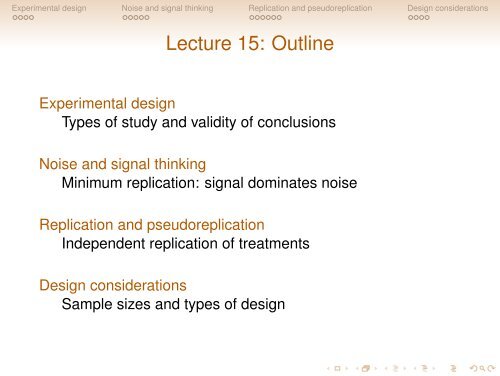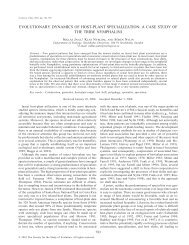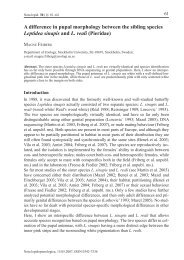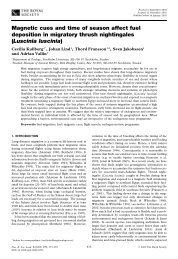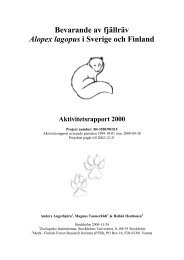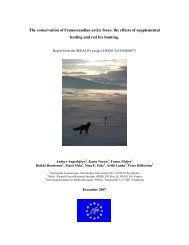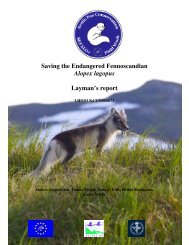Lecture 15: Outline
Lecture 15: Outline
Lecture 15: Outline
You also want an ePaper? Increase the reach of your titles
YUMPU automatically turns print PDFs into web optimized ePapers that Google loves.
Experimental design Noise and signal thinking Replication and pseudoreplication Design considerations<br />
<strong>Lecture</strong> <strong>15</strong>: <strong>Outline</strong><br />
Experimental design<br />
Types of study and validity of conclusions<br />
Noise and signal thinking<br />
Minimum replication: signal dominates noise<br />
Replication and pseudoreplication<br />
Independent replication of treatments<br />
Design considerations<br />
Sample sizes and types of design
Experimental design Noise and signal thinking Replication and pseudoreplication Design considerations<br />
Experimental design<br />
The wide subject of experimental design was opened up, aimed at<br />
avoiding waste of effort in the accumulation of ill-planned, indecisive, or<br />
irrelevant observations (R. A. Fisher, 1955)<br />
The aim is to be efficient in drawing valid conclusions from experiments/observations<br />
Example of study that could be improved
Experimental design Noise and signal thinking Replication and pseudoreplication Design considerations<br />
A classification of studies<br />
• Is random assignment used<br />
Yes Experiment<br />
No Is there a control group or multiple measures<br />
Yes Quasi-experiment<br />
No Non-Experiment<br />
• In a true experiment some manipulation (application of<br />
treatments) takes place and treatments are randomly<br />
assigned to units<br />
• In a quasi-experiment there may be some manipulation but<br />
treatment groups are not formed by random assignment<br />
(there is a danger of comparing non-equivalent groups)<br />
• For a non-experiment, it may be uncertain how one should<br />
interpret the observations
Experimental design Noise and signal thinking Replication and pseudoreplication Design considerations<br />
Validity of conclusions<br />
Whether the conclusions from a study are justified or not depends primarily<br />
on how an observation/experiment has been conducted (and not on the<br />
statistics)<br />
• External validity<br />
• Conclusions from study apply to (can be generalized to) a larger<br />
population<br />
• Holds if units are randomly selected from the population<br />
• In many cases external validity will be only approximate or unclear<br />
• Internal validity<br />
• Covariation found in study can be interpreted as a cause-effect<br />
relationship, and not just as a correlation that may be an<br />
expression of reverse causation or third variables<br />
• Holds if treatments are randomly assigned (true experiment)<br />
• In many cases internal validity will be only approximate or unclear
Experimental design Noise and signal thinking Replication and pseudoreplication Design considerations<br />
The scope and validity of a study is always limited<br />
The conclusions from a study might not apply under conditions that are<br />
different from those used during the study<br />
The Spratt-Archer example<br />
This kind of phenomenon is sometimes called “diabolic interaction”
Experimental design Noise and signal thinking Replication and pseudoreplication Design considerations<br />
Noise and signal thinking<br />
Data = signal + noise<br />
Two basic strategies<br />
• Reduce noise<br />
• use replication to average out noise<br />
• control error variation by blocking<br />
• explain error variation with covariate<br />
• careful handling of individuals<br />
• Enhance and/or resolve signal<br />
• Increase difference between treatment levels or increase<br />
range of variation of x-variable<br />
• resolve effect of several factors in balanced design
Experimental design Noise and signal thinking Replication and pseudoreplication Design considerations<br />
Minimum replication<br />
Replication of treatments is needed to draw conclusions from a study<br />
(because we need to compare between and within treatment group variability)<br />
But when the statistical units are large, expensive, or time consuming to treat<br />
and observe, it can be hard to achieve sufficient replication, for instance for<br />
• individuals of certain species, like large mammals<br />
• large spatial units, like a forest, a lake or a river<br />
• local (biological) populations<br />
• artificial selection lines<br />
• large cages, enclosures, large aquaria, artificial ponds, climate<br />
chambers, large pieces of land that are manipulated<br />
• blocks of time when a comparison is made (like one trial per week)<br />
It would be nice to know the minimum amount of replication that could be<br />
sufficient<br />
The minimum occurs for strong treatment effects, i.e. when “signal dominates<br />
noise”
Experimental design Noise and signal thinking Replication and pseudoreplication Design considerations<br />
Sample size when signal dominates noise<br />
Comparing two groups: t-test or Wilcoxon two-sample test (Mann-Whitney)<br />
First example<br />
Group 1 (n 1 = 2)<br />
y = 5.13, 5.46<br />
Group 2 (n 2 = 2)<br />
y = 25.52, 26.22<br />
t-test: t = 51.2, df = 2, p = 0.0004<br />
Wilcoxon: W = 0, p = 0.33<br />
Try to avoid such small n-values<br />
Second example<br />
Group 1 (n 1 = 4)<br />
y = 10.3, 13.1, 12.7, 9.5<br />
Group 2 (n 2 = 4)<br />
y = <strong>15</strong>.3, 14.6, 16.1, 13.9<br />
t-test: t = 3.57, df = 6, p = 0.012<br />
Wilcoxon: W = 0, p = 0.029<br />
Borderline respectable n-values<br />
With four units in each group the Wilcoxon two-sample test gives significance<br />
when each value from one group is smaller than each value from the other<br />
Seems safer to have at least five units in each group
Experimental design Noise and signal thinking Replication and pseudoreplication Design considerations<br />
Sample size when signal dominates noise<br />
Paired comparison: paired t-test or Wilcoxon matched-pairs test<br />
First example<br />
Unit Test Control<br />
1 11.21 5.20<br />
2 10.08 4.62<br />
3 10.63 5.07<br />
t-test: t = 33.6, df = 2, p = 0.0009<br />
Wilcoxon: V = 6, p = 0.25<br />
Try to avoid such small n-values<br />
Second example<br />
Unit Test Control<br />
1 8.41 6.20<br />
2 9.26 8.14<br />
3 7.52 6.93<br />
4 10.38 8.33<br />
5 8.96 7.01<br />
6 9.43 7.57<br />
t-test: t = 6.21, df = 5, p = 0.002<br />
Wilcoxon: V = 21, p = 0.031<br />
Acceptable n-value<br />
With six paired comparisons Wilcoxon gives significance when all go in the<br />
same direction<br />
Seems safer to have at least seven comparisons
Experimental design Noise and signal thinking Replication and pseudoreplication Design considerations<br />
Sample size when signal dominates noise<br />
Correlation: product-moment (regular) or Spearman<br />
First example<br />
Unit y 1 y 2<br />
1 2.41 1.24<br />
2 5.35 2.64<br />
3 8.14 4.06<br />
Correlation: r = 0.9998, p = 0.012<br />
Spearman: r S = 1.0, p = 0.33<br />
Try to avoid such small n-values<br />
Second example<br />
Unit Test Control<br />
1 6.28 3.20<br />
2 8.33 3.90<br />
3 8.91 4.61<br />
4 10.30 5.57<br />
5 11.04 5.89<br />
Correlation: r = 0.983, p = 0.003<br />
Spearman: r S = 1.0, p = 0.017<br />
Acceptable n-value<br />
With five units Spearman gives significance when ranking is perfect<br />
Seems safer to have at least six units
Experimental design Noise and signal thinking Replication and pseudoreplication Design considerations<br />
Replication and pseudoreplication<br />
• Replication: statistically independent repetition of the application of a<br />
treatment or a treatment combination to experimental/observational<br />
units<br />
• The purpose of replication is to get an estimate of variability within<br />
treatment, which can then be compared with variability between<br />
treatments<br />
• With greater replication, the noise in the signal-noise compound is<br />
reduced through averaging<br />
• Pseudoreplication is defined as the use of inferential statistics to test for<br />
treatment effects with data from experiments where either treatments<br />
are not replicated (though samples may be) or replicates are not<br />
statistically independent (Hurlbert 1984)<br />
• The problem with pseudoreplication is that a statistically significant test<br />
is often interpreted as firm evidence for a treatment effect, but this<br />
interpretation can be unwarranted
Experimental design Noise and signal thinking Replication and pseudoreplication Design considerations<br />
What is a replicate<br />
A replicate can be identified with an experimental or observational unit, by<br />
way of the application or assignment of a treatment or by random selection<br />
A replicate is<br />
• the thing to which a treatment is applied<br />
• each application of a treatment should be an independent act, without<br />
random components that are correlated with other treatment applications<br />
• if there are correlated random components among replicates, they are in<br />
fact pseudoreplicates<br />
• the thing which is randomly selected from a population<br />
• if it is unclear what the population is or what the procedure of selection is,<br />
it is also unclear what the experimental or observational unit is<br />
• if two or more populations are compared, but it is unclear how the samples<br />
were selected, the comparison also becomes unclear<br />
• a minimum requirement is that the same, possibly imperfect, sampling<br />
procedure is used in each population (this is actually a very common<br />
approach, since random sampling is very difficult)<br />
The validity of a study depends crucially on the proper identification of<br />
replicates
Experimental design Noise and signal thinking Replication and pseudoreplication Design considerations<br />
Different kinds of replication<br />
From Hurlbert 1984
Experimental design Noise and signal thinking Replication and pseudoreplication Design considerations<br />
Common sources of pseudoreplication<br />
• Shared enclosure<br />
• Data for each treatment come from individuals in the same enclosure<br />
• Common environment<br />
• Data for each treatment come from individuals sharing the same<br />
environment<br />
• Relatedness<br />
• Data for each treatment come from genetically related individuals<br />
• Pseudoreplicated stimulus<br />
• The same test stimulus is used for all individuals in a treatment group<br />
• Social environment<br />
• Other individuals are part of the environment for social animals<br />
• Temporal correlation<br />
• Repeated observation on the same unit at several points in time<br />
• Phylogeny<br />
• Failing to properly account for evolutionary relations in comparative study
Experimental design Noise and signal thinking Replication and pseudoreplication Design considerations<br />
Randomization<br />
For an experiment, randomization means that units have equal chances of ending up in<br />
each treatment group<br />
For sampling from a population, randomization means that any individual has an equal<br />
chance of being included in the sample<br />
Advantages of randomization<br />
• eliminate unrecognized systematic effects of “third variables”<br />
• this is the reason why we can conclude cause-and-effect relations from a<br />
true experiment<br />
• achieve an unbiased estimate of some property of a population<br />
• this is the main method of obtaining an unbiased estimate<br />
Possible disadvantages of randomization<br />
• by chance units with certain properties might be overrepresented in a treatment<br />
group<br />
• this is an argument for using a systematic procedure for assigning<br />
treatment (e.g., every second unit is assigned to treatment and every<br />
second to control)<br />
• a random sample is only representative on average<br />
• what we really want is a representative sample
Experimental design Noise and signal thinking Replication and pseudoreplication Design considerations<br />
Unsuitable alternatives to randomization<br />
There are some rather common but unsuitable methods of assigning<br />
treatments or forming a sample<br />
• Haphazard sampling<br />
• Instead of getting a truly random sample, some other unspecified<br />
means of obtaining a collection of units is used<br />
• Self-selection<br />
• Those units that are most easy to get hold of are sampled<br />
• Doing one treatment at a time<br />
• It can seem convenient and more efficient to first do one<br />
treatment, then the next (or the control), but this should be avoided<br />
Systematic sampling or systematic assignment of treatments (e.g., every<br />
second unit is control) could be an acceptable alternative to randomization<br />
If randomization seems to give a biased outcome (e.g., all control squares<br />
end up in one end of the study area), one possibility is to randomize again
Experimental design Noise and signal thinking Replication and pseudoreplication Design considerations<br />
How to decide on sample sizes<br />
There are a few different procedures that are sometimes used to decide on sample<br />
sizes<br />
• Go for the absolute maximum that you can possibly achieve<br />
• This might seem like a good choice, but has the drawbacks that you might<br />
waste effort, cause suffering to experimental animals, or reduce the quality<br />
of the procedure (by becoming too exhausted or bored)<br />
• Use whatever number of units you already happen to have available<br />
• This is sometimes the only possibility, but otherwise it has no real<br />
advantage<br />
• Follow an established tradition<br />
• This can be a very good way of deciding on sample size (and other<br />
aspects of design), but one should also critically evaluate previous<br />
approaches, to see if changes are called for<br />
• Make an explicit power calculation to determine a reasonable sample size<br />
• This is the best way, but it requires that you have an idea of the size of<br />
treatment effects you are looking for and the within-treatment variability<br />
you can expect (if you do not have any idea about these things, you are<br />
gambling)
Experimental design Noise and signal thinking Replication and pseudoreplication Design considerations<br />
Different experimental designs<br />
Depending on the questions asked and the practical circumstances for a study,<br />
different experimental designs may be used<br />
Examples of common designs<br />
• completely randomized design<br />
• this is a simple design where each unit is randomly assigned to a<br />
treatment category<br />
• factorial design<br />
• this is like the completely randomized design, except that treatment<br />
combinations (corresponding to combinations of levels of two or more<br />
factors) are used instead of simple treatments<br />
• randomized complete blocks design<br />
• units are divided into blocks of hopefully similar units and random<br />
assignment of treatments occur only within a block (randomized paired<br />
design is an example)<br />
• split-plot design<br />
• there is a hierarchical set of units, where plots are randomly assigned to<br />
one treatment type and subplots are randomly assigned to another<br />
treatment type; leads to a mixed model analysis
Experimental design Noise and signal thinking Replication and pseudoreplication Design considerations<br />
Number of treatments versus replication<br />
• If we have a limited supply of units available, but are aiming for many<br />
treatments or treatment combinations, there will be few replicates per<br />
treatment, leading to little averaging out of within treatment variation<br />
and decreasing the power of between treatment comparisons<br />
• Having many treatments also leads to the issue of multiple<br />
comparisons, where further losses of power may occur<br />
• This is a rather strong argument for the use of relatively simple designs,<br />
since these in a way correspond to a larger sample size<br />
• Nevertheless, the argument should not prevent us from investigating<br />
scientifically important interactions using factorial designs<br />
• Careful analysis and planning is called for if one is going to perform an<br />
expensive or laborious experiment with many treatments or treatment<br />
combinations
Experimental design Noise and signal thinking Replication and pseudoreplication Design considerations<br />
Some advice<br />
Keep it simple. Many advanced designs are possible, with different treatment factors,<br />
blocking factors and covariates. These features can have advantages, but they also<br />
have costs. It is always a good idea to have a balanced design.<br />
Finally, some ancient wisdom


